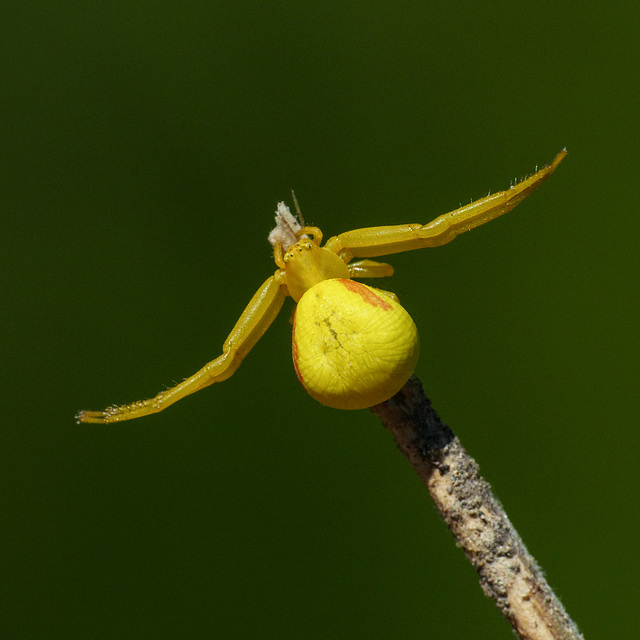See also...
Keywords
Authorizations, license
-
Visible by: Everyone -
All rights reserved
-
238 visits
Tiny Crab Spider


On 27 July 2014, a few of us had a "tour" of a naturalist's garden, as part of an Open House here in the city. I was glad to have the chance to take a few photos of some colourful flowers, including Showy Milkweed.. This tiny Crab Spider had obviously slowly changed its colour to camouflage itself against the yellow flowers on which it was first found. In a comment box below is another photo of the same spider, posted previously.
"Thomisidae do not build webs to trap prey, though all of them produce silk for drop lines and sundry reproductive purposes; some are wandering hunters and the most widely known are ambush predators. Some species sit on or beside flowers or fruit, where they grab visiting insects. Individuals of some species, such as Misumena vatia, are able to change color over a period of some days, to match the flower on which they are sitting. Some species frequent promising positions among leaves or bark, where they await prey, and some of them will sit in the open, where they are startlingly good mimics of bird droppings.
These spiders may be yellow or white, depending on the flower in which they are hunting. Especially younger females, which may hunt on a variety of flowers such as daisies and sunflowers, may change color "at will". Older females require large amounts of relatively large prey to produce the best possible clutch of eggs. They are therefore, in North America, most commonly found in goldenrod (Solidago sp.), a bright yellow flower which attracts large numbers of insects, especially in autumn. It is often very hard even for a searching human to recognize one of these spiders on a yellow flower. The color change from white to yellow takes between 10 and 25 days, the reverse about six days." From Wikipedia.
en.wikipedia.org/wiki/Misumena_vatia
"Thomisidae do not build webs to trap prey, though all of them produce silk for drop lines and sundry reproductive purposes; some are wandering hunters and the most widely known are ambush predators. Some species sit on or beside flowers or fruit, where they grab visiting insects. Individuals of some species, such as Misumena vatia, are able to change color over a period of some days, to match the flower on which they are sitting. Some species frequent promising positions among leaves or bark, where they await prey, and some of them will sit in the open, where they are startlingly good mimics of bird droppings.
These spiders may be yellow or white, depending on the flower in which they are hunting. Especially younger females, which may hunt on a variety of flowers such as daisies and sunflowers, may change color "at will". Older females require large amounts of relatively large prey to produce the best possible clutch of eggs. They are therefore, in North America, most commonly found in goldenrod (Solidago sp.), a bright yellow flower which attracts large numbers of insects, especially in autumn. It is often very hard even for a searching human to recognize one of these spiders on a yellow flower. The color change from white to yellow takes between 10 and 25 days, the reverse about six days." From Wikipedia.
en.wikipedia.org/wiki/Misumena_vatia
- Keyboard shortcuts:
Jump to top
RSS feed- Latest comments - Subscribe to the comment feeds of this photo
- ipernity © 2007-2024
- Help & Contact
|
Club news
|
About ipernity
|
History |
ipernity Club & Prices |
Guide of good conduct
Donate | Group guidelines | Privacy policy | Terms of use | Statutes | In memoria -
Facebook
Twitter

Sign-in to write a comment.